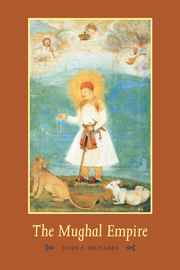Book contents
- Frontmatter
- Contents
- List of maps and tables
- General editor's preface
- Preface
- Introduction
- 1 Conquest and stability
- 2 The new empire
- 3 Autocratic centralism
- 4 Land revenue and rural society
- 5 Jahangir 1605–1627
- 6 Shah Jahan 1628–1658
- 7 The War of Succession
- 8 Imperial expansion under Aurangzeb 1658–1689
- 9 The economy, societal change, and international trade
- 10 Maratha insurgency and Mughal conquest in the Deccan
- 11 The Deccan Wars
- 12 Imperial decline and collapse, 1707–1720
- Conclusion
- Glossary
- Bibliographic essay
- Index
- THE NEW CAMBRIDGE HISTORY OF INDIA
General editor's preface
Published online by Cambridge University Press: 28 March 2012
- Frontmatter
- Contents
- List of maps and tables
- General editor's preface
- Preface
- Introduction
- 1 Conquest and stability
- 2 The new empire
- 3 Autocratic centralism
- 4 Land revenue and rural society
- 5 Jahangir 1605–1627
- 6 Shah Jahan 1628–1658
- 7 The War of Succession
- 8 Imperial expansion under Aurangzeb 1658–1689
- 9 The economy, societal change, and international trade
- 10 Maratha insurgency and Mughal conquest in the Deccan
- 11 The Deccan Wars
- 12 Imperial decline and collapse, 1707–1720
- Conclusion
- Glossary
- Bibliographic essay
- Index
- THE NEW CAMBRIDGE HISTORY OF INDIA
Summary
The New Cambridge History of India covers the period from the beginning of the sixteenth century. In some respects it marks a radical change in the style of Cambridge Histories, but in others the editors feel that they are working firmly within an established academic tradition.
During the summer of 1896, F. W. Maitland and Lord Acton between them evolved the idea for a comprehensive modern history. By the end of the year the Syndics of the University Press had committed themselves to the Cambridge Modern History, and Lord Acton had been put in charge of it. It was hoped that publication would begin in 1899 and be completed by 1904, but the first volume in fact came out in 1902 and the last in 1910, with additional volumes of tables and maps in 1911 and 1912.
The History was a great success, and it was followed by a whole series of distinctive Cambridge Histories covering English Literature, the Ancient World, India, British Foreign Policy, Economic History, Medieval History, the British Empire, Africa, China and Latin America; and even now other new series are being prepared. Indeed, the various Histories have given the Press notable strength in the publication of general reference books in the arts and social sciences.
What has made the Cambridge Histories so distinctive is that they have never been simply dictionaries or encyclopedias. The Histories have, in H. A. L. Fisher's words, always been “written by an army of specialists concentrating the latest results of special study”. Yet as Acton agreed with the Syndics in 1896, they have not been mere compilations of existing material but original works.
- Type
- Chapter
- Information
- The Mughal Empire , pp. xiii - xivPublisher: Cambridge University PressPrint publication year: 1993

